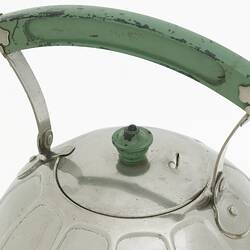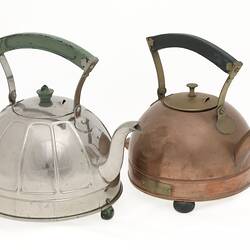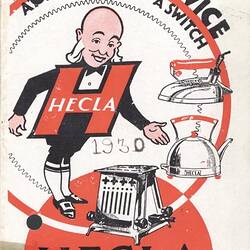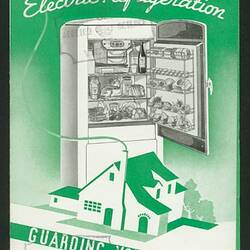Summary
Auto Safety stainless steel, dome-shaped kettle manufactured by Hecla Electrics Pty Ltd, Melbourne, Australia, in about 1933.
Features decorative panels impressed into the steel body and a removable lid. Kettle also has a steam release opening and a black bakelite pouring handle and lid handle that are both painted green. The kettle is fixed to round black bakelite supports that are also painted green.
Physical Description
Stainless steel dome-shaped kettle with 'S' shaped spout and decorative panels impressed into the steel all over the kettle body. The removable lid has a raised opening for steam release and a black bakelite handle painted green. The pouring handle is black bakelite, painted green and sits high above the kettle fixed to metal supports. Designed to accept standard flat 2-pin 240 V AC electric power cord. There are three small round black bakelite feet with patches of green paint attached to the base of the kettle.
Significance
Hecla Electrics Pty Ltd were a significant Melbourne manufacturing company, who became a household name in the 1920s making small electric appliances such as heaters and kettles. They also made a variety of other electrical appliances for domestic, commercial and military use. The company manufactured electric appliances in Melbourne from about 1922 until the 1980s, although Clarence Marriott, who formed the company, had begun making radiators with his father James in 1899. The company had a reputation for quality products. The company also played an important role within the Australian domestic and commercial appliance industry, both as a leading innovator and through its role in training skilled staff, many of whom went on to work for competitors such as Kambrook, Electrolux and Sunbeam.
This electric coffee percolator represents the typical small domestic appliance that the Hecla company was famous for. Along with other items in the Hecla Collection, it highlights the diversity of electric appliances that the company made. This object also highlights the legacy of high quality design and metal construction work that Clarence and James established for the company, stemming from their early work as talented art metal workers. It also represents the first major period of the take-up of electricity use in the home. This take-up began in the 1920s and 1930s with the use of small appliances, and by the 1950s electricity had become commonplace in the home, and large appliances such as refrigerators and stoves became standard.
More Information
-
Collection Names
-
Collecting Areas
-
Acquisition Information
Donation from Mr Phil Wollen, 22 Oct 2004
-
Manufacturer
Hecla Co, Victoria, Australia, circa 1933
Hecla advertising suggests this was made about 1933 but as the advertising archive is not complete it could have been made earlier or later. -
Inscriptions
Base of kettle with Hecla volcano logo: HECLA AUTO SAFETY / KETTLE / 230 / 250 V / 950 W / SERIAL / 35921 / PAT. NOS. / 5731-27 / 16597-28 / MADE IN AUSTRALIA / TO RESET CUT-OFF / PUSH IN ROD Power supply socket verso: 3 PT
-
Brand Names
-
Classification
Domestic life, Food & drink preparation, Appliances - water heating
-
Category
-
Discipline
-
Type of item
-
Overall Dimensions
27.5 cm (Length), 20.5 cm (Width), 23.5 cm (Height)
Kettle body including spout and handle protrusions.
-
Overall Dimensions
8.7 cm (Length), 8.7 cm (Width), 4 cm (Height)
Lid with handle.
-
Dimensions
273 mm (Length), 205 mm (Width), 240 mm (Height)
Measurement From Conservation.
-
References
Collection includes a significant amount of archival material.
-
Keywords
Electric Appliances, Household Appliances, Kettles, Innovation & Design







